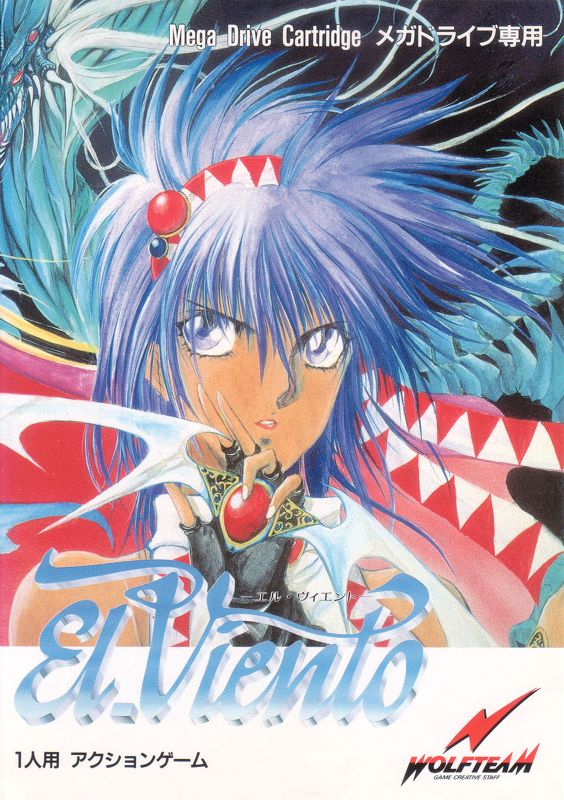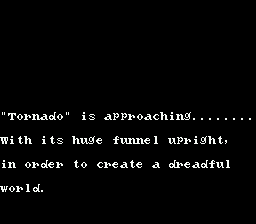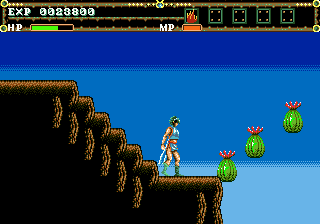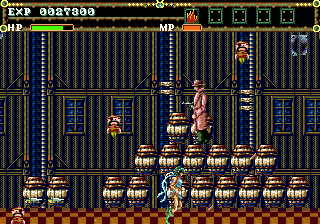Retro Replay Review
Gameplay
El Viento’s gameplay is a thrilling blend of side-scrolling action and precision platforming that keeps you on your toes from the moment you pick up the controller. Playing as Annet, you wield the mystic boomerang—the eponymous “El Viento”—which can be thrown in multiple directions, ricocheting off walls and enemies. The control scheme is intuitive and responsive, making it easy to chain attacks and escape dangerous encounters. Whether you’re tackling standard goons or dodging the dark magic cast by Hastur’s cultists, the game’s flow feels natural and well-balanced.
(HEY YOU!! We hope you enjoy! We try not to run ads. So basically, this is a very expensive hobby running this site. Please consider joining us for updates, forums, and more. Network w/ us to make some cash or friends while retro gaming, and you can win some free retro games for posting. Okay, carry on 👍)
Throughout the game’s stages—ranging from dank sewers to hidden cavern systems and grimy city rooftops—you’ll discover various bonus items and power-ups that enhance Annet’s abilities. Health boosts, temporary boomerang upgrades, and special orbs add a tactical layer: do you rush ahead to clear a room or backtrack to secure every collectible? This scavenger-hunt aspect lends replay value, as finding hidden caches can fluctuate the challenge and open new strategies for boss battles.
Boss encounters in El Viento strike a satisfying balance between pattern memorization and on-the-fly adaptation. Each major adversary, from the mob-backed gang leaders to Hastur’s grotesque lieutenants, introduces unique attack telegraphs. You’ll need to study their sequences, time your throws, and position Annet precisely to exploit their vulnerabilities. These multi-phase fights can be intense, but the generous checkpoint system keeps frustration at bay while still demanding skillful play.
Cooperative elements are notably absent, but that doesn’t detract from the solo experience. The level design cleverly incorporates vertical elements—think beams, ladders, and collapsing platforms—so you constantly have to juggle movement and offense. The combination of tight controls, diverse enemy types, and a satisfying risk-reward system for item collection makes El Viento’s gameplay loop both addictive and memorable.
Graphics
For a 16-bit era title, El Viento showcases remarkably detailed sprite work and richly textured backgrounds that evoke 1930s New York’s gritty underbelly. Characters are rendered with expressive animations: Annet’s hair swishes dynamically during high jumps, while enemies flinch and recoil in convincing ways when struck. The animators paid attention to small flourishes—like the boomerang slicing through air—which add fluidity to each encounter.
The color palette leans heavily into moody blues, grays, and muted tones, reinforcing the game’s dark cult aesthetic. Occasional bursts of crimson—especially in ritual chambers or mob backrooms—provide stark contrast and underscore the sinister atmosphere. Environmental details, such as flickering lampposts in alleyway sections or dripping water in the sewers, are more than mere decoration: they deepen immersion and hint at hidden pathways.
Layered parallax scrolling helps the world feel alive and three-dimensional, despite the side-scroll perspective. As Annet traverses rooftops against a skyline backdrop, you can see distant zeppelins drifting by, while ground stages feature rats scuttling in the foreground. These touches demonstrate the developers’ dedication to crafting a believable setting, making each stage visually distinct and contributing to the game’s overall mood.
Special effects—like the glowing aura around magic projectiles or the smoke billowing from destroyed machinery—are handled with surprising polish. Bosses often introduce their own visual gimmicks, such as swirling portals or undead hands emerging from the floor, ensuring that each confrontation feels unique. While hardware limitations occasionally produce color bleed or sprite flicker during heavy on-screen action, these moments are rare and never detract significantly from the spectacle.
Story
Set in 1930s New York, El Viento thrusts you into a world where organized crime and eldritch cultists have formed an unholy alliance. Their sinister goal: to resurrect the Dark Prince Hastur and seize dominion over the city—and eventually, the entire globe. Dialogue interludes and brief cutscenes lay out this high-stakes conflict with pulp-horror flair, evoking classic noir serials and Lovecraftian mythos.
At the heart of the narrative is Annet Myer, a young woman born of Hastur’s cursed bloodline yet resolutely opposed to her dark heritage. She emerges as a compelling protagonist: driven by a personal vendetta but burdened by the knowledge that she alone can stand against her own lineage. Scenes in which Annet reflects on her past and steels herself for the trials ahead lend emotional weight to otherwise relentless action sequences.
While the overarching plot follows a fairly linear progression—journey through the city, infiltrate hideouts, face off with cult leaders—the game peppers in atmospheric storytelling through environmental clues. Graffiti scrawls, newspaper clippings about missing persons, and abandoned ritual sites hint at the mob’s widespread corruption. You’ll find your imagination filling in backstories for minor characters and subplots, which deepens investment beyond mere button-mashing.
Cutscenes between stages are short but effective, using dramatic camera angles and on-model art that matches in-game sprites. Though voice acting is absent, text dialogue is punchy and occasionally tinged with dry wit, especially when Annet spars verbally with her underworld adversaries. This balance of grim supernatural stakes and lighter banter helps maintain pacing and keeps the story engaging throughout its runtime.
Overall Experience
El Viento succeeds as both an action-platformer and a stylistic period piece. Its blend of supernatural horror, 1930s gangster intrigue, and a strong female lead gives it a distinctive identity in a crowded genre. The satisfying boomerang mechanics and varied level design ensure every stage feels fresh, while the atmospheric graphics and sound design pull you deep into the game’s dark narrative.
The challenge level strikes an admirable middle ground—accessible to newcomers yet offering depth for veterans who want to master boss patterns or uncover every hidden item. The checkpoint system respects your time, making retries quick and teaching you to learn from mistakes rather than punishing you endlessly. As a result, the game maintains forward momentum without ever feeling unfairly difficult.
Replayability is bolstered by the hunt for hidden power-ups and alternate paths; speedrunners will appreciate the nuances of boomerang trajectory, while completionists can savor the satisfaction of 100% item collection. The absence of multiplayer doesn’t diminish the fun, as the core action is tightly focused on Annet’s solo quest. Fans of retro side-scrollers, horror themes, and period settings will find a lot to love here.
In summary, El Viento offers a polished, atmospheric adventure that stands out for its era-appropriate graphics, solid gameplay, and engaging storyline. Whether you’re drawn to its Lovecraftian overtones, 1930s backdrop, or simply enjoy fast-paced platform combat, this game delivers a memorable, action-packed journey through a city teetering on the brink of dark resurrection.
 Retro Replay Retro Replay gaming reviews, news, emulation, geek stuff and more!
Retro Replay Retro Replay gaming reviews, news, emulation, geek stuff and more!









Reviews
There are no reviews yet.